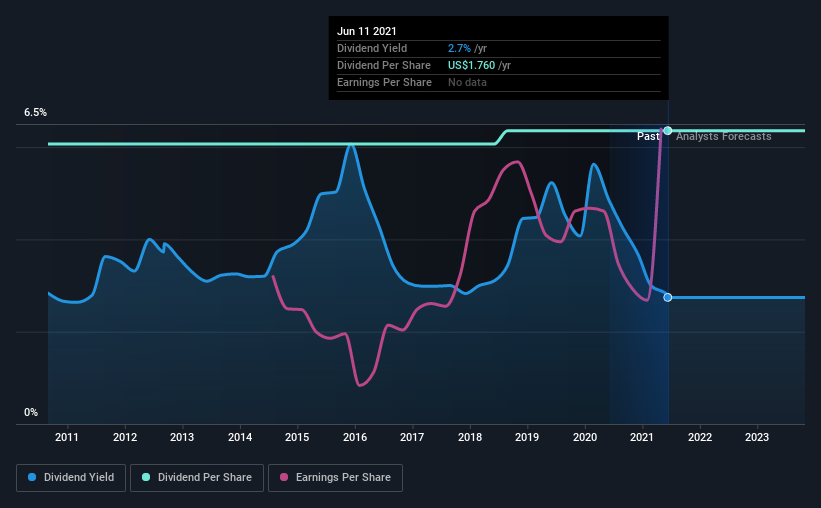Greif (NYSE:GEF) Could Be A Buy For Its Upcoming Dividend
It looks like Greif, Inc. (NYSE:GEF) is about to go ex-dividend in the next four days. Typically, the ex-dividend date is one business day before the record date which is the date on which a company determines the shareholders eligible to receive a dividend. The ex-dividend date is of consequence because whenever a stock is bought or sold, the trade takes at least two business day to settle. Thus, you can purchase Greif's shares before the 18th of June in order to receive the dividend, which the company will pay on the 1st of July.
The company's next dividend payment will be US$0.44 per share, on the back of last year when the company paid a total of US$1.76 to shareholders. Looking at the last 12 months of distributions, Greif has a trailing yield of approximately 2.7% on its current stock price of $64.16. If you buy this business for its dividend, you should have an idea of whether Greif's dividend is reliable and sustainable. That's why we should always check whether the dividend payments appear sustainable, and if the company is growing.
Check out our latest analysis for Greif
Dividends are typically paid from company earnings. If a company pays more in dividends than it earned in profit, then the dividend could be unsustainable. That's why it's good to see Greif paying out a modest 36% of its earnings. Yet cash flow is typically more important than profit for assessing dividend sustainability, so we should always check if the company generated enough cash to afford its dividend. It distributed 28% of its free cash flow as dividends, a comfortable payout level for most companies.
It's positive to see that Greif's dividend is covered by both profits and cash flow, since this is generally a sign that the dividend is sustainable, and a lower payout ratio usually suggests a greater margin of safety before the dividend gets cut.
Click here to see the company's payout ratio, plus analyst estimates of its future dividends.
Have Earnings And Dividends Been Growing?
Stocks in companies that generate sustainable earnings growth often make the best dividend prospects, as it is easier to lift the dividend when earnings are rising. If business enters a downturn and the dividend is cut, the company could see its value fall precipitously. It's encouraging to see Greif has grown its earnings rapidly, up 27% a year for the past five years. Greif is paying out less than half its earnings and cash flow, while simultaneously growing earnings per share at a rapid clip. Companies with growing earnings and low payout ratios are often the best long-term dividend stocks, as the company can both grow its earnings and increase the percentage of earnings that it pays out, essentially multiplying the dividend.
The main way most investors will assess a company's dividend prospects is by checking the historical rate of dividend growth. Greif's dividend payments are broadly unchanged compared to where they were 10 years ago.
The Bottom Line
From a dividend perspective, should investors buy or avoid Greif? Greif has been growing earnings at a rapid rate, and has a conservatively low payout ratio, implying that it is reinvesting heavily in its business; a sterling combination. There's a lot to like about Greif, and we would prioritise taking a closer look at it.
So while Greif looks good from a dividend perspective, it's always worthwhile being up to date with the risks involved in this stock. In terms of investment risks, we've identified 2 warning signs with Greif and understanding them should be part of your investment process.
If you're in the market for dividend stocks, we recommend checking our list of top dividend stocks with a greater than 2% yield and an upcoming dividend.
This article by Simply Wall St is general in nature. It does not constitute a recommendation to buy or sell any stock, and does not take account of your objectives, or your financial situation. We aim to bring you long-term focused analysis driven by fundamental data. Note that our analysis may not factor in the latest price-sensitive company announcements or qualitative material. Simply Wall St has no position in any stocks mentioned.
Have feedback on this article? Concerned about the content? Get in touch with us directly. Alternatively, email editorial-team (at) simplywallst.com.

